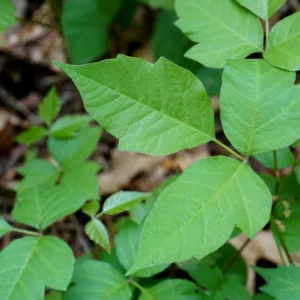Whether you are working in the yard or walking in the woods, encountering poisonous plants puts a huge damper on the day, and the itchy days that follow. Here’s how to properly identify poison ivy and other poisonous plants before they suck the fun out of your summer.
Common Traits of a Tricky Trio
Beware hikers and homeowners! Poison ivy, oak, and sumac all possess the power to irritate. This is due to an oily coating called urushiol. It covers the leaves, stems, and even the roots of this tricky trio of plants. Coming in contact with any part of the plant transfers the oil to your skin, causing an itchy rash to arise not long after. All three types of these plants cause the same symptoms on skin: itchy, red, swollen patches often accompanied by blisters.
How to Identify Poison Ivy
What makes it difficult to identify poison ivy is that its appearance changes depending on the season, location, and type of environment. The leaves, however, always have pointed tips and cluster around a stem in threes, the middle leaf being larger than the outer ones. Growing as a low shrub or vine, the poison ivy’s leaves are green in summer, yellow or orange in fall, and have a reddish hue in spring. Yellow-green flowers and whitish berries often appear in the summer.
Poison Oak
Poison oak also possesses a cluster of three leaves, however, some varieties of this shrub-like plant have more. Found on both coasts in the United States but not often in the central states, this poisonous plant boasts leaves that resemble oak tree leaves. Green in spring, yellowish green in summer, and brown in fall, the leaves are slightly scalloped with rounded tips that differentiate them from poison ivy.
Poison Sumac
Often found in swampy conditions and humid environments, poison sumac grows as a small tree or tall shrub. The long oval-shaped leaves of poison sumac are smooth edged and turn orange in spring, dark green in summer, and reddish orange in fall. Unlike poison ivy and oak, though, sumac features anywhere from seven to 13 leaves on each of its reddish stems.
Call Us for Help Identifying Poison Ivy
It’s bad enough when weeds spoil the appearance of your lawn, but poisonous ones are even more of a problem. Hopefully, this article helps you identify poison ivy easily, allowing you to enjoy summer rash free and ready for wherever the trails take you. Call Free Spray Lawn Care today at 419-529-5296 to discuss unwanted weeds in your yard.



Comments (0)
Thanks for your comment!
Thanks for your feedback! Your comments have been successfully submitted! Please note, all comments require admin approval prior to display.
Error submitting comment!
There is a problem with your comment, please see below and try again.